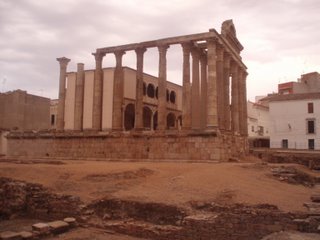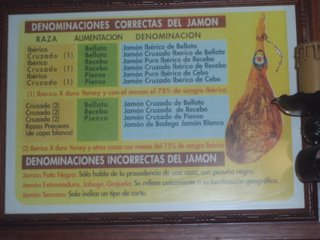






DAY FIVE: MERIDA: WHAT HAVE THE ROMANS EVER DONE FOR US?
Little to report about Caceres in the morning. Some decent coffee and chocolate and we were off on the very short hop to Merida.
Merida draws its name from its origins as Augustus Emerida, given to the largest Roman colony in Spain. The Emeritii were Roman soldiers who, having acquitted themselves well were granted land.
The city soon became the largest on the Iberian peninsular and the focal point of culture and politics in the province of Lusitania.
A lot has changed since then.
The Rough Guide, a trifle unfairly, I think, describes the city as “no great shakes” It is true, certainly that the new town is bustling, lively but, unremarkable. However, what distinguishes this city from any other on our journey is that it is home to the finest collection and the best preserved Roman ruins in the whole of Spain and possibly in Europe outside Rome itself.
Although most of our accommodation on the trip had been in 2* places, we like a bit of pampering as much as the next middle aged man, so HP had arranged our over night stay in Merida to be at the beautiful Parador de Merida, a converted 18th Century Convent. Quite lovely and still only £100 between us.
After we parked the car, we rushed out to catch a few of the sights before they closed for the afternoon siesta.
It is hard to describe just how impressive they are. The Amphitheatre is amongst the best preserved anywhere and, in its heyday, would have held nearly 16,000 people all baying for the blood of wild animals or gladiators. Walking around the site certainly gives you an insight into an entirely different world.
Likewise, so does the Teatro. Again one of the best preserved from the western Roman Empire and still used today for music festivals and performances of classical theatre.
The town was simply littered with ruins and I don’t just mean me and HP. It is a staggering array and quite made us need a beer to calm ourselves.
In terms of food, quite a mix. From the tourist places which employ people to thrust flyers into your hands as you enter the historical sites to the local bars where even in the meanest one, you are still offered a free snack with your cheap beer. One in particular called Cafeteria San Lucia which was just on the Plaza Espana offered up some of the best fried fish I had tried in Spain.
After a few (plus a few more) we were in need of nappage, so headed back to the Parador to sit in the beautiful peace and quiet of our room which overlooked the ornamental gardens and the burbling fountains and restore our energies for the next few days. These flying DH holidays can be quite an assault course and, without the daily siesta (surely the one thing that on its own marks Spain out as the most civilised country on earth ) I am unsure that we would be up to the task being naturally quite delicate of constitution.
By the evening however, we were quite restored to good humours and ready to face a little more sightseeing and, necessarily, more food and drink.
First though, the Museo Romano. Built by a famous Spanish architect whose name quite escapes me, the museum in Merida is undoubtedly one of the finest I have visited in every aspect. The building to house the collection is astonishing both in its scale and its sensitivity to the artefacts. The collection is equally breathtaking in its scope and in the quality of preservation and, best of all, underneath the building, uncovered when it was being built, are well preserved Roman roads and buildings. We spent a long time in there and learned a great deal courtesy of an excellent audio tour.
By 8pm, we were more than toured out and needed to move on to some modern wonders of the deep fried kind. Again a very mixed bag, ranging from one bar who I am keen to blot from my mind who served microwave fresh tapita with the cold spots to prove it to 100 Montadito which really did offer 100 types of small Bocadillo to a primarily student crowd. Best of all, however, was Casa Benito, a bar run by an ex bullfighter where we enjoyed a crunchy plate of Puntalittas, small cuttlefish like seafood.
I can understand why The Rough Guide may think Merida to be nothng remarkable. Take away the Roman ruins and there is little about it to distinguish it from a thousand other Spanish towns. But, that is missing the point. It is a typical Spanish town and that is what makes it a very great shake in our book. There is nowhere quite like them and it was a great place to spend a day.
As a final note to our evening there we sat in the square and had a nightcap. On the TV, Spain were in the process of being humiliated by Northern Ireland in a football match. During the rest of our stay, TV had been dominated by the Spanish victory in the Basketball World Cup (who knew such a minor sport for girls could have a world cup? I guess it takes all sorts) but it is a measure of the people that they took success and defeat in the same stride and were, as much as I could discern, magnanimous in both although it did require a six hour talk show for them to fathom out quite how it happened.










0 Comments:
Post a Comment
<< Home